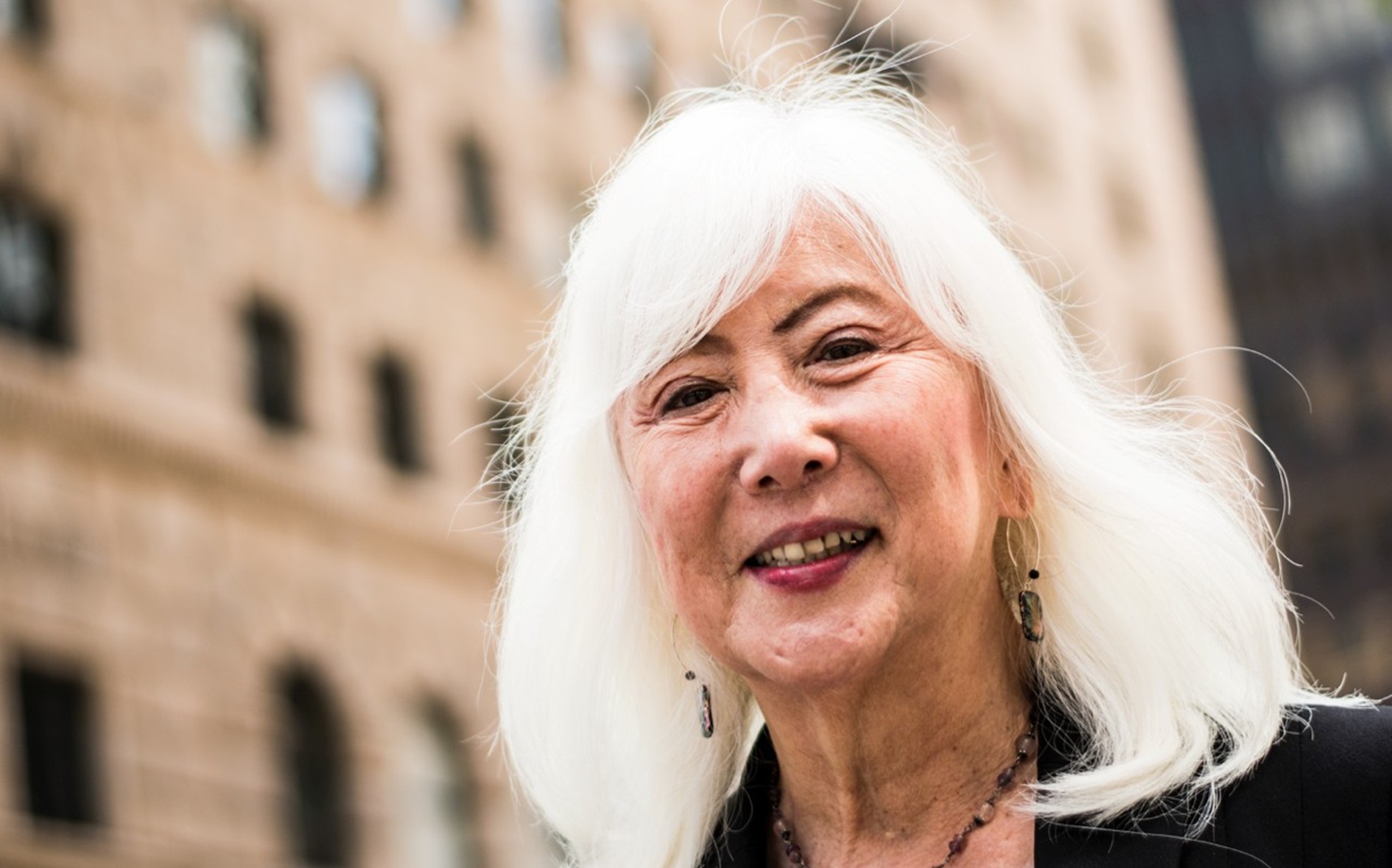Mia Yamamoto
Breaking Chains and Building Bridges
Her story is one of courage, sacrifice and solidarity with those pushed to society’s periphery: for decades, Mia Yamamoto hid her true self as a trans woman while fiercely advocating for the marginalized and uniting diverse groups to amplify unheard voices. Since birth, she has shared the fate of the incarcerated – a reality that continues to shape her to this day:
Born doing time
Mia Frances Akiko Yamamoto was a child of war – not by allegiance, but by ancestry. Following Pearl Harbor, President Roosevelt signed Executive Order 9066, authorizing the internment of over 110,000 Americans of Japanese descent. Although Mia’s ancestors immigrated legally in 1885 and her parents were born in Hawaii – a U.S. territory granting citizenship – they and their children were among 17,000 Japanese Americans forcibly detained to the Poston War Relocation Center. It was there, behind barbed wire, that Mia was born in 1943: “I was born doing time because I was Japanese”, rendering her a prisoner just by virtue of her birth.
Mia rejects government terms like “internment”, deliberately calling Poston a concentration camp – a term used by Roosevelt and taught by her mother, warning against euphemisms whitewashing injustice to obscure parallels to Nazi Germany. When the camps were established, Mia’s father Elmer Yamamoto – the first Asian-American graduate of Loyola Law School – remained in L.A. to help others, separating the family from their church community sent to Manzanar. Elmer openly opposed internment, arguing the Constitution forbade imprisoning people by race. But Mia remembers: “Of course he was wrong. Race matters – and it still matters today.” The Supreme Court upheld this wrongdoing as “military necessity” in Korematsu v. US, with rare and unsuccessful legal challenges. Only Mitsuye Endo’s case prevailed, but many detainees had already been released.
The camps closed in 1946, with Mia’s family among the last released because Elmer was deemed subversive1) and dangerous for his studies and outspokenness. After the war, he faced segregation. Although he was barred from the all-white L.A. County Bar Association, he continued practicing law until his death in 1957. Years later, Mia saw his impact when community members thanked her for his legal help they could not have afforded otherwise. Though a reserved Nisei, her father’s courage inspired Mia’s lifelong fight for the marginalized.
Although too young to remember the camps, Mia’s childhood was shaped by their aftermath. Her parents and five siblings moved to a farm in Orange County seeking peace. But racial hostility forced them to relocate to East L.A., where violence persisted – even bullets were fired at their home. At school, her brothers faced attacks for being Japanese and Mia recalls hearing “Kill the Japs” often, her “first lesson about race.” To avoid being targeted, Mia stopped speaking Japanese in public. At home, her older brothers turned their trauma into anger, unleashing it on their younger siblings which caused her to fight back. But when Mexican-American teenagers refused to tolerate how the Yamamotos were treated in the neighborhood and stood up for them, unexpected allies emerged – leading her brother to join a local gang and her mother to embrace the culture. This community gave them safety and belonging, shaping Mia’s understanding of cross-cultural solidarity.
A Life between Silence and Song
But Mia’s struggles extended beyond racism. From age five, she knew her assigned gender did not reflect her true self. But she quickly learned to hide it, describing her childhood as “torture”. Growing up in a harsh, masculine and catholic2) environment where feminine expression was brutally suppressed, she imitated her brothers to survive. Born Michael Francis Yamamoto, she later chose the name “Mia”, meaning “mine” and feminized her middle name to honor her mother Frances, a registered nurse who raised the six children alone after Elmer’s death.

©The Outwords Archive
In 1952, Mia read about Christine Jorgensen, the first publicly known trans woman in the U.S. – a proof she was not alone. Yet, when Mia shared it, her mother’s tears revealed how painful and taboo her truth was. So Mia buried her identity. She saw the backlash against Jorgensen: labeled “satanic” and banned from media, Mia understood early that the lasting opposition to transsexuals were never about safety but political tools used by right-wing groups to spread fear and oppression, often cloaked in religion.3)
Mia recalls the dangers trans people faced: “A lot of us get killed out there. The police […] hit us.” In 1959, this violence sparked the Cooper’s Donuts riot in L.A., where trans patrons fought back against police harassment, a first local flare-up. Fearing this hostility, Mia suppressed her identity continuously, finding refuge in music. She sang in choirs and was surrounded by her mother’s Hawaiian melodies and her brother’s rock ‘n’ roll, helping her to survive: “There was always another gig, another jam, […] another reason to keep going”.
Battles Within and Without
Mia’s school years were characterized by academic difficulties and personal turbulence, “flopping around from school and being a disappointment to everybody”. She graduated despite poor grades but fell into depression and suicidal thoughts. Struggling through her first two semesters of college, she failed every class and eventually took a grocery store job. Still, Mia held onto her father’s example, reapplied to L.A. City College and later transferred to Cal State University L.A. where she studied Government and English.
In 1966, amid the Vietnam War, Mia volunteered for the U.S. Army, driven by a sense of duty and to escape stigma: “If I died in battle, I could spare my family from the shame of my secret”. Once labeled an enemy at birth, she now defended the nation and received several military honors. But war quickly shattered her illusions: “Nobody wins, everybody loses. War is evil.” She saw people of color sent by a white-led nation to kill others of color in the name of colonial power. This fueled Mia’s support for the Vietnamese-American community. In the army, where being LGBTQ+ was illegal, many people like Mia hid their identities to avoid dishonorable discharge. She adopted a male impersonation to survive in what she called “the absolute most extreme of male toxicity.” This erased the contributions of queer soldiers under policies like “Don’t Ask, Don’t Tell.”
While still serving in 1967, Mia applied to UCLA Law School, describing herself as a poet needing work to fund her art. She was admitted early, but returning from war, Mia was guilt-driven and emotionally scared. She condemned violence, vowed to oppose all wars and joined many other Sanseis into the anti-war movement before expanding her activism to racial and social justice for all people of color.
One fight, many fronts
During law school, Mia explored her gender identity by dressing as a woman, even though gender-nonconforming clothing risked arrest. The emerging LGBTQ+ movement, led by the Stonewall Uprising and figures like Sylvia Rivera and Marsha P. Johnson, faced widespread hostility and violence – “queens” got murdered, as Mia remembers. At that time, she researched in libraries for terms like “transgenderism” found in the literature, hoping for a “cause and a cure”. After her graduation in 1971, she co-founded the Asian Pacific Islander Law Student Association – at a time when only nine Asian students were enrolled. Mia helped securing additional seats, fostering solidarity with Black and Chicano law students. She viewed this cross-racial unity as essential: “people coming together is the most important catalyst for the future.”4)
As a lawyer, Mia could finally afford therapy, first to process war trauma, then to face her gender identity. In group sessions, she saw deep suffering: many were suicidal, rejected by their families and trapped in despair. Trans lives remained mostly invisible or stigmatized, limited to pornography and homelessness and, in her legal work, to prostitution or drug use. After years of therapy, Mia abandoned hope for a “cure.” When her first therapist said she was transgender, she fired him. Decades later, she accepted gender identity as “inescapable, incurable and immutable,” a lifelong battle against an inherent truth that ultimately wins.
Mia began as a Legal Aid attorney, committed to helping the poor. But she felt unfulfilled after three years. A friend’s request to cover a missed public defender interview let her to her true calling. Initially hesitant about criminal defense, often dismissed in law school as unworthy, Mia recognized most clients as “good people making reckless, stupid decisions”, shaped by poverty, discrimination and trauma.5) She noticed patterns of racial targeting, childhood violence and neglect6), holding individuals accountable while condemning a violent system.7) For a decade, she defended many trans sex workers, empathizing deeply: “it represented a choice I didn’t make.” She sometimes came out to clients, who called her a coward for not doing so publicly. But Mia believed she could help more as Michael than as Mia: “Their lives, their futures, were on my shoulders”.
In the 1970s and 1980s, Mia defended protesters, inspired by the Black liberation movement and her father’s activism with NAACP and ACLU.8) She came to see all civil rights movements as one ongoing fight: “it’s really all the same struggle […] it just has different phases.”9) In that spirit, Mia cofounded the Asian Pacific American Bar Association to strengthen the community’s voice. But although she valued her work as a public defender,10) Mia opened a private practice focused on civil rights and political cases to make a broader impact11). She even defended abusive clients when she saw potential for change,12) determined to show that Asian American lawyers could be skilled and compassionate.13) Mia strongly believes in redemption and rejects defining people solely by their worst acts.14)
“I will die as a woman”
Soon, Mia faced deep personal struggles again, feeling isolated and unsure where she fit as a transgender person, not relating to common trans narratives like street life or performance. But after years of hiding, the burden became unbearable: “I can’t fight it […] It just is.” Accepting herself was frightening, but dying as a man felt like never having lived. On her 60th birthday, praised a “great guy”, she only felt guilt and anger, calling herself two things she hates the most: “complete phony” and a “coward”. Having never expected to live past her father’s age, Mia saw this as her last chance15) to live authentically. No more hiding, no more lies. And even if harmed after her transition, she resolved: “I will die as a woman”16).
In 2003, Mia publicly transitioned, becoming California’s first openly transgender lawyer. Coming out meant risking everything – relationships, family, and career – but she called it “the most revolutionary act” that frees both yourself and others. She began by telling her family, waiting until both parents had passed, knowing they would struggle to understand.17) Most relatives were troubled but eventually accepted her. One brother, however, reacted with anger, cutting off all contact and disinheriting her. Although deeply hurt,18) Mia thanked him for being the family rebel who taught her to defy expectations. Mia stayed close to his children, even forming a band with them – the J-Town Rebels – carrying forward that rebellious spirit.
Coming out was emotionally difficult, with long-term friends turning away and one publicly questioning Mia’s right to be a woman.19) Mia never romanticized her transition20) or demanded blind acceptance – only the chance to prove herself.21) Transitioning at 60 also raised questions, including from her lawyer partner, but her answer was simple: “Because it’s the truth.” Mia told each client individually about her transition, offering help to find another lawyer – but not a single one left. She then informed prosecutors and judges, willing to step down if it caused prejudice, but no one objected either. On her first day in court as Mia, she aimed to “liberate the courthouse” by finally living authentically. While she noticed surprise outside the courtroom, inside she was met with warmth: a prosecutor asked how to address her, she simply replied “I call myself Mia”, and thanked him. Judges congratulated her and colleagues lined up to offer hugs, moving her to tears.
When the Daily Journal featured her transition on its front page, it helped normalize her identity in the legal community and connected her with other transgender lawyers. As California’s first openly transgender attorney, Mia feels pressure to be exceptional and prove that transgender and Asian American lawyers can excel.22) In 2015, Mia married Kimberlee Tellez whom she admires as a “ferocious woman” committed to social justice.
For the greater good
Mia has tried over 200 jury trials and defended thousands of clients. Beyond the courtroom, she contributed to international justice through International Bridges for Justice. But despite her success, she struggled with the tension between public accomplishments and her hidden identity: Winning awards like “Criminal Defense Lawyer of the Year” as Michael, she felt disconnected and often declined them.23) After her transition, those awards took on new meaning24) – not just personally, but as symbols of hope and representation for transgender women.25)
During the Trump administrations, Mia became an assertive advocate against attacks on marginalized groups, including Muslims and immigrants: “I represent a community that’s being targeted not just by bigots but by the president”. She particularly condemned the 2017 transgender military ban as oppressive and as effort to erase LGBTQAI+ soldiers’ existence and sacrifices.
Despite widespread fear, Mia responded defiantly: “There’s no great courage without great fear.” For her, coalition building is a moral duty – a way to protect the vulnerable by fostering understanding against “political fascists” who profit from dividing minorities. Mia urges solidarity on the front lines of peace.26) She hopes all marginalized groups unite, as “anything we do for our own little community is meaningless if it doesn’t contribute […] to the greater good.”27)
Further sources and readings:
- Funk, The Book of Pride: LGBTQ Heroes Who Changed the World, 2019.
- “Mia’s Mission” (short movie).
- Legal Talk Network: “Lived & Learned: Present as your true self, says Mia Yamamoto”, 25.06.2018.
- MSNBC: “Trans Lawyer Builds Career Fighting For The Poor”, 09.07.2015.
- Reflections with Raja – Podbean: “Mia Yamamoto”, 30.09.2020.
- Asian America: The Ken Fong Podcast: “EP 15: Mia Yamamoto On Coming Out As Transgender Later in Life”, 17.08.2015.
- San Diego County Bar: “Dialogue on Diversity Transgender Rights in 2024”, 13.03.2024.
- The Purple Reign Podcast: “Mia Yamamoto Part 1 and 2”, 01.08.2019 and 08.08.2019.
- additional podcasts with Mia can be found here.
References
| ↑1 | Filisko, The Stonewall Legacy: ABA commission creates an award commemorating a key moment for LGBT rights, ABA Journal February 2013 Vol. 99 No. 2, p. 59. |
|---|---|
| ↑2 | Yamamoto/Chestnut, Mia Yamamoto and Shelby Chestnut In Conversation, 59 Harv. C.R.-C.L. L. Rev. 17 2024, p. 28. |
| ↑3 | Yamamoto/Chestnut, Mia Yamamoto and Shelby Chestnut In Conversation, 59 Harv. C.R.-C.L. L. Rev. 17 2024, p. 35. |
| ↑4 | Kwong/Wang/Yamamoto, Queer and Asian: A Public Forum, Asian Pacific American Law Journal Vol. 16 No. 1 (Fall 2010-Spring 2011), p. 41. |
| ↑5 | Yamamoto, A Life of Service: An Interview With Mia Yamamoto, Asian Pacific American Law Journal Vol. 13 No. 1 (Fall 2007-Spring 2008), p. 2. |
| ↑6 | Yamamoto, Violence/One Person Cn Make a Difference: A Criminal Defense Attorney Reflects on the Case of Duc Ta, Amerasia Journal Vol. 31 Issue 3 2005, p. 21. |
| ↑7 | Yamamoto, A Life of Service: An Interview With Mia Yamamoto, Asian Pacific American Law Journal Vol. 13 No. 1 (Fall 2007-Spring 2008), p. 3. |
| ↑8 | Yamamoto/Chestnut, Mia Yamamoto and Shelby Chestnut In Conversation, 59 Harv. C.R.-C.L. L. Rev. 17 2024, p. 38. |
| ↑9 | Yamamoto/Chestnut, Mia Yamamoto and Shelby Chestnut In Conversation, 59 Harv. C.R.-C.L. L. Rev. 17 2024, p. 38. |
| ↑10, ↑12 | Yamamoto, A Life of Service: An Interview With Mia Yamamoto, Asian Pacific American Law Journal Vol. 13 No. 1 (Fall 2007-Spring 2008), p. 4. |
| ↑11 | Yamamoto/Chestnut, Mia Yamamoto and Shelby Chestnut In Conversation, 59 Harv. C.R.-C.L. L. Rev. 17 2024, p. 37. |
| ↑13 | Yamamoto, A Life of Service: An Interview With Mia Yamamoto, Asian Pacific American Law Journal Vol. 13 No. 1 (Fall 2007-Spring 2008), p. 5. |
| ↑14 | Yamamoto, A Life of Service: An Interview With Mia Yamamoto, Asian Pacific American Law Journal Vol. 13 No. 1 (Fall 2007-Spring 2008), p. 6. |
| ↑15 | Yamamoto, A Life of Service: An Interview With Mia Yamamoto, Asian Pacific American Law Journal Vol. 13 No. 1 (Fall 2007-Spring 2008), p. 18. |
| ↑16 | Rawles, Life Lessons, ABA Journal Vol. 104 No. 7 July 2018, p. 65. |
| ↑17 | Yamamoto, A Life of Service: An Interview With Mia Yamamoto, Asian Pacific American Law Journal Vol. 13 No. 1 (Fall 2007-Spring 2008), p. 19. |
| ↑18, ↑21 | Yamamoto, A Life of Service: An Interview With Mia Yamamoto, Asian Pacific American Law Journal Vol. 13 No. 1 (Fall 2007-Spring 2008), p. 16. |
| ↑19 | Yamamoto, A Life of Service: An Interview With Mia Yamamoto, Asian Pacific American Law Journal Vol. 13 No. 1 (Fall 2007-Spring 2008), p. 16. |
| ↑20 | Yamamoto, A Life of Service: An Interview With Mia Yamamoto, Asian Pacific American Law Journal Vol. 13 No. 1 (Fall 2007-Spring 2008), p. 17. |
| ↑22 | Yamamoto/Chestnut, Mia Yamamoto and Shelby Chestnut In Conversation, 59 Harv. C.R.-C.L. L. Rev. 17 2024, p. 32. |
| ↑23 | Yamamoto, A Life of Service: An Interview With Mia Yamamoto, Asian Pacific American Law Journal Vol. 13 No. 1 (Fall 2007-Spring 2008), p. 20. |
| ↑24 | Yamamoto, A Life of Service: An Interview With Mia Yamamoto, Asian Pacific American Law Journal Vol. 13 No. 1 (Fall 2007-Spring 2008), p. 20. |
| ↑25 | Yamamoto, A Life of Service: An Interview With Mia Yamamoto, Asian Pacific American Law Journal Vol. 13 No. 1 (Fall 2007-Spring 2008), p. 21. |
| ↑26 | Kwong/Wang/Yamamoto, Queer and Asian: A Public Forum, Asian Pacific American Law Journal Vol. 16 No. 1 (Fall 2010-Spring 2011), p. 32. |
| ↑27 | Yamamoto/Chestnut, Mia Yamamoto and Shelby Chestnut In Conversation, 59 Harv. C.R.-C.L. L. Rev. 17 2024, p. 15, 35. |




It is regrettable that the author uses the term transgenderism, which is essentially only used by transphobic activists, to describe the research about transidentity and gender.
Thank you for your comment. I understand your concerns regarding the term “transgenderism.” However, I would like to point out that Mia herself used this term in her original statements (interview, timestamp 00:35:44 – Burying Transgender Identity: https://theoutwordsarchive.org/interview/yamamoto-mia/). She conducted her research on this term at a time when it still carried a different meaning. Therefore, the term is used here in its historical context.
Nonetheless, I appreciate your critical feedback and agree that the nuances of this context should be more clearly conveyed. I will try to arrange for a source to be added that explains the historical usage and highlights the contrast with the term’s despicable misuse today.